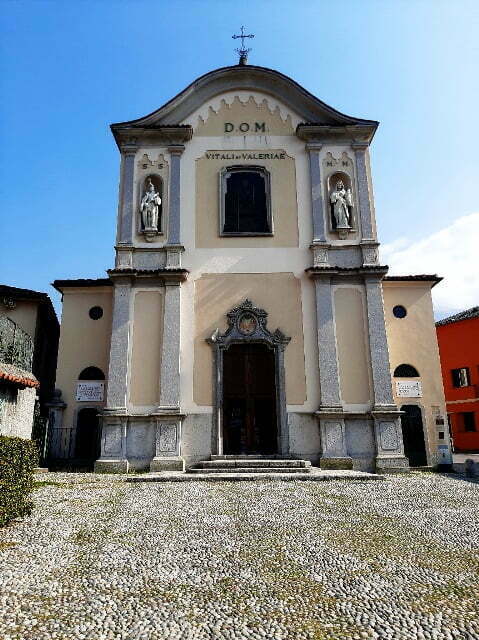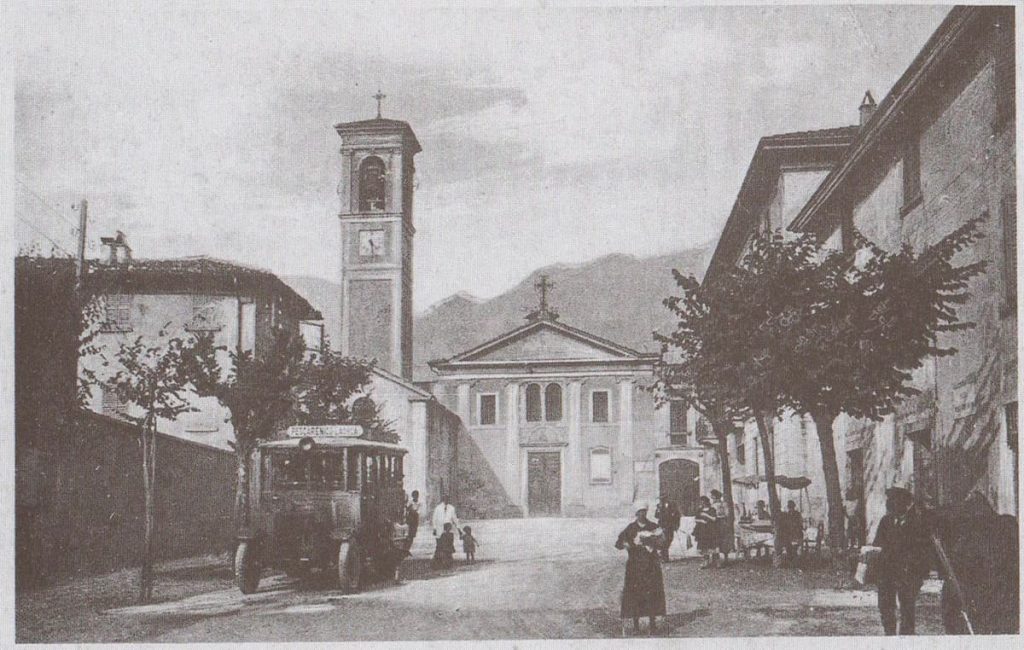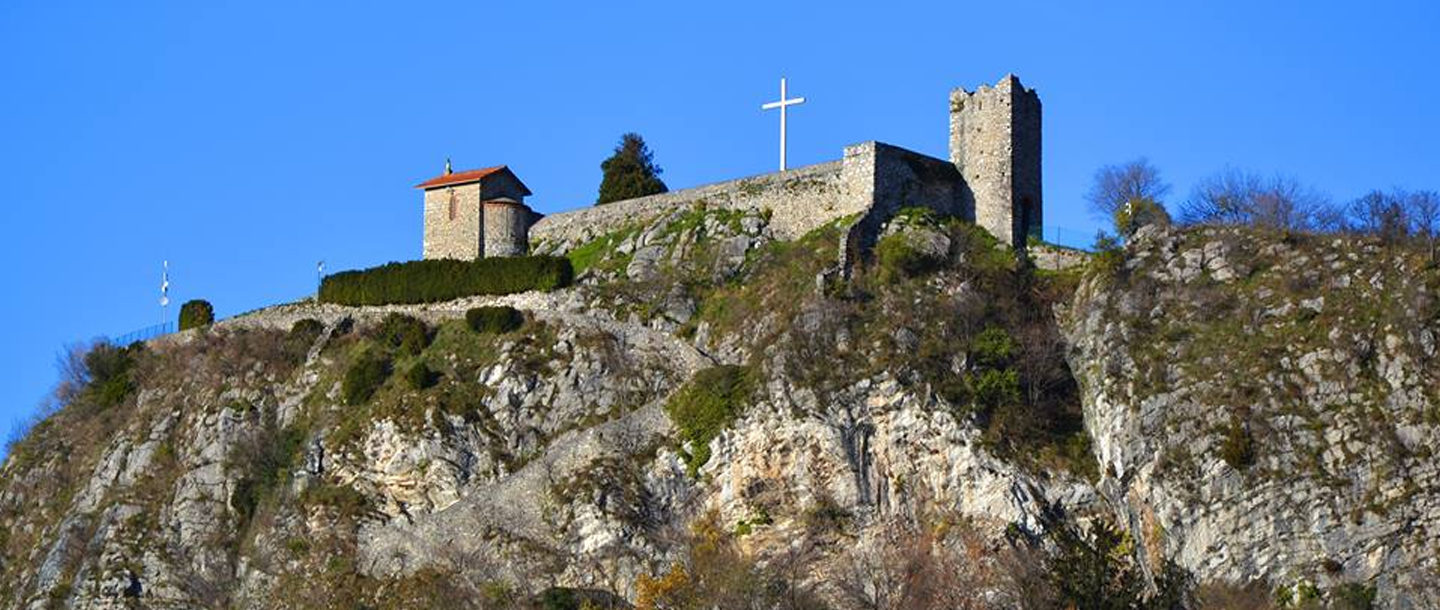First stop: The lackeys’ tabernacle
In chapter I of “I Promessi Sposi” Manzoni describes the path of Don Abbondio towards home. He
makes us walk along a straight road which forks at a certain point: on the right it branches out the
small road that leads to Resegone, on the left the one which goes down to the valley, characterized
by the presence of a low wall.
At the junction of the two streets subject of the description we find a tabernacle depicting
meandering figures, flames, souls in Purgatory and it is precisely at this point that the curate meets
the lackeys, event that determines the birth of the whole story.
The slump that Don Abbondio runs along, can be identified with a small road on the left, which
rises from the current roundabout in Viale Montegrappa towards the district of Acquate. The
tabernacle mentioned by Manzoni is located in via Tonio and Gervaso: it has been rebuilt and does
not house any pictorial depiction. There is a plaque that recalls Manzoni’s text.


Second stop: Don Abbondio’s Church
It seems that there are two churches addressed to Don Abbondio: the church of Santi Vitale and
Valeria in Olate and the Church of San Giorgio in Acquate.
In chapter VII, the church square becomes the scene of confusion due to the attempt of the failed
marriage between Renzo and Lucia. When the two, with a play, manage to enter the curate’s house,
their intention is to pronounce the formula that would bind them forever. However this attempt
reveals a failure, in fact Don Abbondio looking outside the window asking for help.
The nearest church to Lucia’s house is that of the Saints Vitale and Valeria: the first news date back
to 1400. The same year we know for sure that there was a small church dedicated to the saints
mentioned.
In 1427 a small square-shaped bell tower was built; at the beginning of the next century Olate and
Bonacina communities destroyed part of the ancient church and moved the front side of this tower
towards the center of Lecco. The aisle dates back to 1700 and then it is modified again in the first
decades of 1900. In general, there aren’t many news about the history of this holy place. It’s certain
that it is the result of various stylistic elements.


Third stop: Lucia’s house
In Lecco we can spot two places identified as Lucia’s house and both of them are in the district of
Olate and Acquate.
The architecture is simple and very typical of the territory of Lecco: a courtyard, a balcony and
wooden stairs that bring us in a linear two-storey building.
Manzoni, with his words, guides us in this cottage from the small courtyard. Here we can find
Renzo who is getting closer to the house of his future bride, as we can read in chapter II of the
novel.
In this extract he probably made a reference to Lucia’s alleged house in Olate. Currently the
residence is private and we’re not able to visit it; near Don Abbondio’s church in Acquate instead
we find Lucia’s traditional house. From here you can see the hill where the building of Don Rodrigo
stood.



Forth stop: Pescarenico and Fra’ Cristoforo’s convent
The place that is precisely indicated by Manzoni in chapter IV is Pescarenico, fishing village which
is reflected on the Adda. Here stands what is considered to be Fra’ Cristoforo’s convent.
Built in 1576 at the behest of the Spanish governor Hurtado de Mendoza, the Church in question,
dedicated to Saints Lucia and Materno, hosted the Capuchins until 1810, the year in which
Napoleon decided to suppress the order.
Ruins of the ancient convent structure remain in the courtyard and in the portico where they
overlooked the monks’ cells. Over the years the church has been subjected to revisions: we can see
it in the neoclassical facade, a project by the Lecco’s architect Giuseppe Bovara.
It is precisely in relation to the aforementioned church that Manzoni provides an accurate
description of the character and Fra Cristoforo’s appearance, Lucia’s confessor and a figure of great
spirituality.



Fifth stop: in Lecco’s suburbs
The rectory of Chiuso and the Innominato castle
At the rectory of Chiuso the Innominato conversion becomes true. The village of Chiuso is
appoined in the first editorial office of the novel, the Fermo and Lucia of 1822.
This is the brief description that Manzoni makes of it:
where one of the really existing figures mentioned in the novel lived. This part was then deleted in
the definitive version. It deals with Don Serafino Morazzone, confessor of Manzoni
Right in the rooms of the aforementioned rectory, the meeting between Cardinal Federico Borromeo
and Innominato, a moment depicted in the fresco of the painter Casimiro, built in 1871, would have
taken place and now it is present in the structure.
The visit can only finish in Vercurago where the so-called castle of the Innominato stands. It is
located about 180 meters above the level of the lake and can be reached on foot through a short
panoramic path. Among the ruins of the castle include a quadrangular enclosure with a tower,
turned into a chapel in 1902. It is said that Manzoni was inspired by this place to set the castle of
the gentleman Don Rodrigo comes back to for the kidnapping of Lucia. The impervious and
cramped location, the presence of an upright and uncomfortable slope to reach it, the bare and rough
streets that bring to the castle become the symbol of the complex and strongly symbolic interiority
of one of whom.



